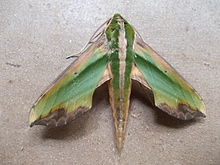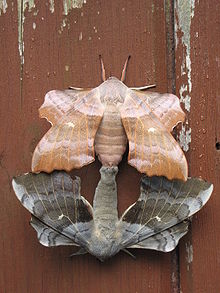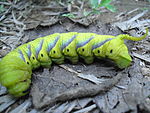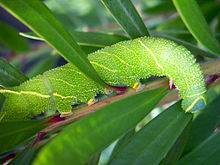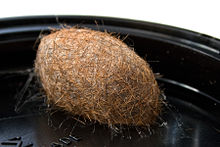- Moth
-
For other uses, see Moth (disambiguation) and Moths (disambiguation).
Moths 
Emperor Gum Moth, Opodiphthera eucalypti Scientific classification Kingdom: Animalia Phylum: Arthropoda Class: Insecta Order: Lepidoptera (unranked): Heterocera A moth is an insect closely related to the butterfly, both being of the order Lepidoptera. Moths form the majority of this order; there are thought to be 150,000 to 250,000 different species of moth (about ten times the number of species of butterfly), with thousands of species yet to be described.[1] Most species of moth are nocturnal, but there are crepuscular and diurnal species.
Contents
Differences between butterflies and moths
Main article: Differences between butterflies and mothsMoths are not easily differentiated from butterflies. Sometimes the name "Heterocera" is used for moths while the term "Rhopalocera" is used for butterflies to formalize the popular distinction; these, however, have no taxonomic validity. Many attempts have been made to subdivide the Lepidoptera into groups such as the Microlepidoptera and Macrolepidoptera, Frenatae and Jugatae, or Monotrysia and Ditrysia. Failure of these names to persist in modern classifications is because none of them represents a pair of "monophyletic groups". The reality is that butterflies are a small group that arose from within the "moths" (being considered as part of Ditrysia of the Neolepidoptera).[2] There is thus no way to group all of the remaining taxa in a monophyletic group, as it will always exclude that one descendant lineage. Also, both their larvae are similar to coleoptera larvae (beetle).
Etymology
Mating pair of Laothoe populi, or Poplar Hawk-moths, showing two different color variants
The Modern English word "moth" comes from Old English "moððe" (cf. Northumbrian "mohðe") from Common Germanic (compare Old Norse "motti", Dutch "Mot" and German "Motte" all meaning "moth"). Perhaps its origins are related to the Old English "maða" meaning "maggot" or from the root of "midge" which until the 16th century was used mostly to indicate the larva, usually in reference to devouring clothes.
The study of butterflies and moths is known as lepidoptery, and biologists that specialize in either are called lepidopterists. As a pastime, watching butterflies and moths is known as butterflying and mothing. The latter has given rise to the term "mother" for someone who engages in this activity - sometimes written with a hyphen (moth-er) to distinguish it from the more common word of the same spelling.[citation needed] This confusion does not arise in speech as it is pronounced differently (/ˈmɒθər/, not /ˈmʌðər/).
Caterpillar
Moth larvae, or caterpillars, make cocoons. When it comes out of the cocoon, it is a fully grown moth with wings. Some moth caterpillars dig holes in the ground, and they will live in the hole until they are ready to turn into a fully grown moth.[3]
Economic significance of moths
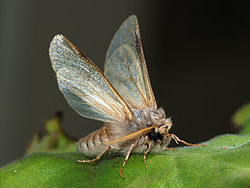 An adult male Pine Processionary Moth (Thaumetopoea pityocampa). This species is a serious forest pest when in larval state. Notice the bristle springing from the underside of the hindwing (frenulum) and running forward to be held in a small catch of the forewing, whose function is to link the wings together.
An adult male Pine Processionary Moth (Thaumetopoea pityocampa). This species is a serious forest pest when in larval state. Notice the bristle springing from the underside of the hindwing (frenulum) and running forward to be held in a small catch of the forewing, whose function is to link the wings together.
Moths, and particularly their caterpillars, are a major agricultural pest in many parts of the world. Examples include corn borers and bollworms.[4] The caterpillar of the gypsy moth (Lymantria dispar) causes severe damage to forests in the northeast United States, where it is an invasive species. In temperate climates, the codling moth causes extensive damage, especially to fruit farms. In tropical and subtropical climates, the diamondback moth (Plutella xylostella) is perhaps the most serious pest of brassicaceous crops.
Several moths in the family Tineidae are commonly regarded as pests because their larvae eat fabric such as clothes and blankets made from natural proteinaceous fibers such as wool or silk.[5] They are less likely to eat mixed materials containing artificial fibers. There are some reports that they can be repelled by the scent of wood from juniper and cedar, by lavender, or by other natural oils. However, many consider this unlikely to prevent infestation. Naphthalene (the chemical used in mothballs) is considered more effective, but there are concerns over its effects on human health. Moth larvae may be killed by freezing the items which they infest for several days at a temperature below −8 °C (18 °F).[6]
Some moths are farmed. The most notable of these is the silkworm, the larva of the domesticated moth Bombyx mori. It is farmed for the silk with which it builds its cocoon. As of 2002[update], the silk industry produces over 130 million kilograms of raw silk, worth about 250 million U.S. dollars, each year.[7][8][9] Not all silk is produced by Bombyx mori. There are several species of Saturniidae that are also farmed for their silk, such as the Ailanthus moth (Samia cynthia group of species), the Chinese Oak Silkmoth (Antheraea pernyi), the Assam Silkmoth (Antheraea assamensis), and the Japanese Silk Moth (Antheraea yamamai).
The mopane worm, the caterpillar of Gonimbrasia belina, from the family Saturniidae, is a significant food resource in southern Africa.
Despite being notorious for eating clothing, most moth adults do not eat at all. Most like the Luna, Polyphemus, Atlas, Prometheus, Cercropia, and other large moths do not have mouths. When they do eat, moths will drink nectar.[5]
Attraction to light
Moths frequently appear to circle artificial lights, although the reason for this behavior remains unknown. One hypothesis advanced to explain this behavior is that moths use a technique of celestial navigation called transverse orientation. By maintaining a constant angular relationship to a bright celestial light, such as the Moon, they can fly in a straight line. Celestial objects are so far away, that even after travelling great distances, the change in angle between the moth and the light source is negligible; further, the moon will always be in the upper part of the visual field or on the horizon. When a moth encounters a much closer artificial light and uses it for navigation, the angle changes noticeably after only a short distance, in addition to being often below the horizon. The moth instinctively attempts to correct by turning toward the light, causing airborne moths to come plummeting downwards, and resulting in a spiral flight path that gets closer and closer to the light source
Predators and parasites of moths
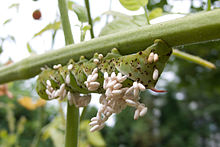 Tomato Hornworm parasitized by braconid wasps.
Tomato Hornworm parasitized by braconid wasps.
Nocturnal insectivores often feed on moths; these include some bats, some species of owls and other species of birds. Moths are also eaten by some species of lizards, cats, dogs, rodents, and some bears. Moth larvae are vulnerable to being parasitized by Ichneumonidae.
 Six-Spot Burnet Moth (Zygaena filipendulae) extracting nectar from a thistle (and thus pollinating it) on the island of Hiiumaa, Estonia.
Six-Spot Burnet Moth (Zygaena filipendulae) extracting nectar from a thistle (and thus pollinating it) on the island of Hiiumaa, Estonia.
Baculoviruses are parasite double-stranded DNA insect viruses that are used mostly as biological control agents. They are members of the Baculoviridae, a family that is restricted to insects. Most baculovirus isolates have been obtained from insects, in particular from Lepidoptera.
There is evidence that ultrasound in the range emitted by bats causes flying moths to make evasive maneuvers because bats eat moths. Ultrasonic frequencies trigger a reflex action in the noctuid moth that cause it to drop a few inches in its flight to evade attack.[10] Tiger moths also emit clicks which foil bats' echolocation.[11][12]
Mottephobia
Mottephobia is the fear of moths. The origin of the word motte is German (meaning moth) and phobia is Greek (meaning fear). As with all things considered phobias this is an irrational fear or hatred, in this particular case it is of moths.
Notable moths
- Atlas moth Attacus atlas – The largest moth in the world
- White Witch moth (Thysania agrippina), the Lepidopteran with the biggest wingspan
- Madagascan Sunset moth (Chrysiridia rhipheus), considered to be one of the most impressive and beautiful Lepidoptera[13]
- Death's-head hawkmoth (Acherontia spp.), is associated with the supernatural and evil and has been featured in art and movies
- Peppered moth (Biston betularia), the subject of a well-known study in natural selection.
- Luna moth (Actias luna)
- Grease Moth (Aglossa cuprina), known to have fed on the rendered fat of humans[14]
- Emperor Gum moth (Opodiphthera eucalypti)
- Polyphemus moth (Antheraea polyphemus)
- Bogong moth (Agrotis infusa), known to have been a food source for Southeastern indigenous Australians
Moths of economic significance:
- Gypsy moth (Lymantria dispar), a pest of hardwood trees in North America
- Corn earworm or cotton bollworm (Helicoverpa zea), a major agricultural pest
- Indianmeal Moth (Plodia interpunctella), a major pest of grain and flour
- Codling moth (Cydia pomonella), a pest mostly of apple, pear and walnut trees
- Light brown apple moth (Epiphyas postvittana), a highly polyphagous pest
- Silkworm (Bombyx mori), for its silk
- Wax moths (Galleria mellonella, Achroia grisella), pests of bee hives
- Duponchelia fovealis, a new invasive pest of vegetable in the United States
See also
- Baculovirus
- Butterfly
- Clothing Moth
- Difference between a butterfly and a moth
- Lepidoptera
- List of moths
- Moth dermatitis
- Pollination
References
- ^ – The Pennsylvania Department of Conservation and Natural Resources
- ^ ""Neolepidoptera" on Tree of Life Web Project<http://tolweb.org/>". 1 January 2003. http://tolweb.org/Neolepidoptera/11719. Retrieved 31 March 2010.
- ^ Darby, Gene (1958). What is a Butterfly. Chicago: Benefic Press. p. 41.
- ^ The First Decade of Genetically Engineered Crops in the United States. USDA.
- ^ a b Scott, Thomas (1995). Concise Encyclopedia Biology. Walter de Gruyter. ISBN 3-11-010661-2. Retrieved on 2009-02-06.
- ^ How to Manage Pests: Pests of Homes, Structures, People, and Pets
- ^ "Table 74. Raw silk: production (including waste)". Food and Agriculture Organization of the United Nations. http://www.fao.org/docrep/004/AD452E/ad452e2a.htm. Retrieved 2008-10-02. "Table lists worldwide raw silk production 132,400 metric tonnes in 2002"
- ^ "Silk Exchanges of Tamil Nadu and Andhra Pradesh". Central Silk Board of India. Archived from the original on March 7, 2003. http://web.archive.org/web/20070307195458/http://www.indiansilk.kar.nic.in/csb/Statistics/forexchg_tasar/forexchg_tasar_Local/SilkFlash/RawSilkPrice_tnap.asp. gives silk prices in rupees. Exchange rate is about 50 RS to dollar.
- ^ "Silk Worm Farming". Vegan Society. Archived from the original on June 19, 2008. http://web.archive.org/web/20080619042940/http://www.vegansociety.com/html/animals/exploitation/silk_worm.php. Retrieved 2008-10-02. "World Raw Silk Production in 1996 is listed as 83,670 metric tonnes"
- ^ Jones, G; D A Waters (2000). "Moth hearing in response to bat echolocation calls manipulated independently in time and frequency.". Proceedings of the Royal Society B Biological Sciences 267 (1453): 1627. doi:10.1098/rspb.2000.1188. PMC 1690724. PMID 11467425. http://www.pubmedcentral.nih.gov/articlerender.fcgi?tool=pmcentrez&artid=1690724. Retrieved 18 August 2009.
- ^ NationalGeographic.com
- ^ NPR.org, Some Moths Escape Bats By Jamming Sonar (video)
- ^ Tait, Malcolm (2006-08-28). "1". Animal Tragic: Popular Misconceptions of Wildlife Through the Centuries. Think Books. p. 38. ISBN 184525015X. http://books.google.com/books?id=o8jDkO2fMTgC&pg=PA38&dq=sunset+moth&sig=0cilixqygrcbn_6e49-x5BH9uls#PPA5,M1. Retrieved 2008-02-19.
- ^ ^ Brundage, Adrienne (March 23, 2009), Other Arthropods of Forensic Importance, Texas A&M University, Texas A&M University Forensic Entomology Lecture
External links
- European Butterflies and Moths by Christopher Jonko
- Museum Witt The World`s Leading Collection of Moths (English)
- Moths of North America Diagnostic large format photographs, taxonomy, descriptions
- Butterflies and Moths at Lepidoptera.pro: Thousands of species and photos
- North American Moth Photographers Group Diagnostic photographs for thousands of species
- Bugguide - Moths
- Back Garden Moths
- UK Lepidoptera
- Helicoverpa Diapause Induction and Moth Emergence Tool
- Pterophoridae of North America
- Moths on the UF / IFAS Featured Creatures Website
Categories:- Moths
- Lepidoptera
- Pollinators
- Agricultural pest insects
- Household pest insects
Wikimedia Foundation. 2010.

